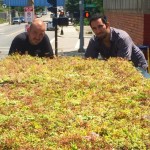ELA Announces Innovative
Green Roofs Initiative in Boston
On July 28th, in a collaboration that was years in the making, the ‘Fairmount Line Bus Shelter Living Roof Initiative’ turned three bus shelters into roof-top, green-spaces near the Talbot Station.
This collaboration brought together the Fairmount-Indigo Line CDC Collaborative, the Talbot Norfolk Triangle Eco Innovation District, and Land Escapes Design Inc., owned by ELA President, Trevor Smith. With advanced preparation and materials donated by Land Escapes Design Inc. and Green Living Technologies International, three bus stop shelters were retrofitted with soil, mixed sedums, and mosses. The green roofs are designed to soak up rainfall before it enters storm drains.
“On an environmental level, it’s about reducing the amount of storm water entering the drainage system,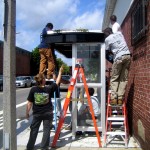 helping to keep the air clean, and providing a green neighborhood aesthetic,” said Michael Chavez, an architectural designer and Enterprise Rose Architectural Fellow for the Fairmount-Indigo Line CDC Collaborative. “Very few people get to see green buildings and green roofs around Boston. This is a way to engage with people in common spaces and on the street to help better explain what green infrastructure is and what the benefits are.”
helping to keep the air clean, and providing a green neighborhood aesthetic,” said Michael Chavez, an architectural designer and Enterprise Rose Architectural Fellow for the Fairmount-Indigo Line CDC Collaborative. “Very few people get to see green buildings and green roofs around Boston. This is a way to engage with people in common spaces and on the street to help better explain what green infrastructure is and what the benefits are.”
The Fairmount-Indigo Line CDC Collaborative is a grassroots community group that works to enhance the living spaces serviced by the Fairmount Commuter Rail, like Dorchester, Mattapan, and Hyde Park.
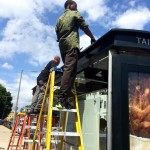 The Fairmount Line Bus Shelter Living Roof Initiative was launched with green roofs installed on three bus shelters, with plans to expand to more bus shelters in the future. This first phase of the project was made possible through generous donations of both time and materials from Land Escapes Design Inc. (a sustainable landscape design company) and Green Living Technologies International (a manufacturer of green roofs and walls).
The Fairmount Line Bus Shelter Living Roof Initiative was launched with green roofs installed on three bus shelters, with plans to expand to more bus shelters in the future. This first phase of the project was made possible through generous donations of both time and materials from Land Escapes Design Inc. (a sustainable landscape design company) and Green Living Technologies International (a manufacturer of green roofs and walls).
The collaboration also included young adults from YouthBuild Boston and the TNT Eco-Teens Program who helped to install the green roofs and will assist in maintaining them. As part of this collaboration, local youth will be trained to do green roof construction and maintenance.
Informational panels were provided by the Environmental Protection Agency’s Soak Up the Rain Campaign to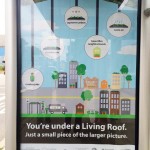 help inform bus commuters and the community about the green roofs. The pilot project is a creative street-level demonstration of how green roof technology can improve environmental conditions including air quality, storm water run-off, and city heat islands, while also creating green jobs.
help inform bus commuters and the community about the green roofs. The pilot project is a creative street-level demonstration of how green roof technology can improve environmental conditions including air quality, storm water run-off, and city heat islands, while also creating green jobs.
This pilot project is designed as a 3-season installation and will stay up through November. With the help of grant funding, the long-term goal is to add green roofs to additional bus shelters and to upgrade the green roof systems next year to allow for native plant material including larger plants to add both beauty and habitat value in the neighborhoods.
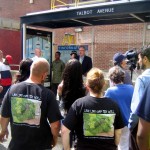 At ELA’s 2014 Conference & Eco-Marketplace, attendees had the opportunity to attend a hands-on, green roof demonstration. Green roof sedum panels from the demonstration were then repurposed as part of the Fairmount Line Bus Shelter Living Roof Initiative. Looking forward, ELA plans to collaborate on the plant material selected for future green roof installations in order to maximize ecological impact.
At ELA’s 2014 Conference & Eco-Marketplace, attendees had the opportunity to attend a hands-on, green roof demonstration. Green roof sedum panels from the demonstration were then repurposed as part of the Fairmount Line Bus Shelter Living Roof Initiative. Looking forward, ELA plans to collaborate on the plant material selected for future green roof installations in order to maximize ecological impact.

